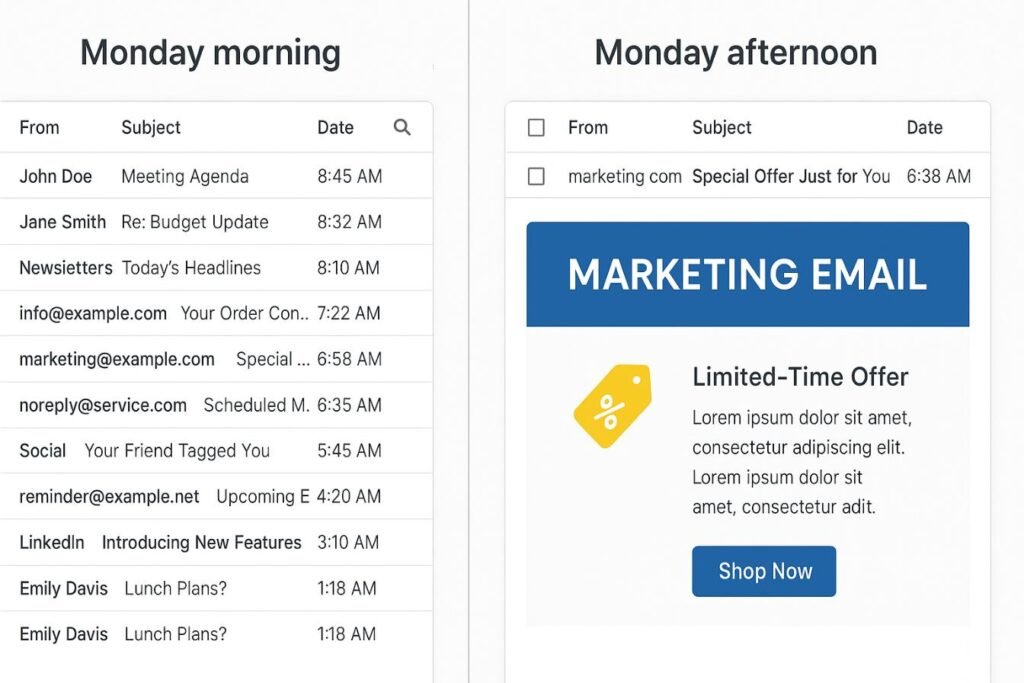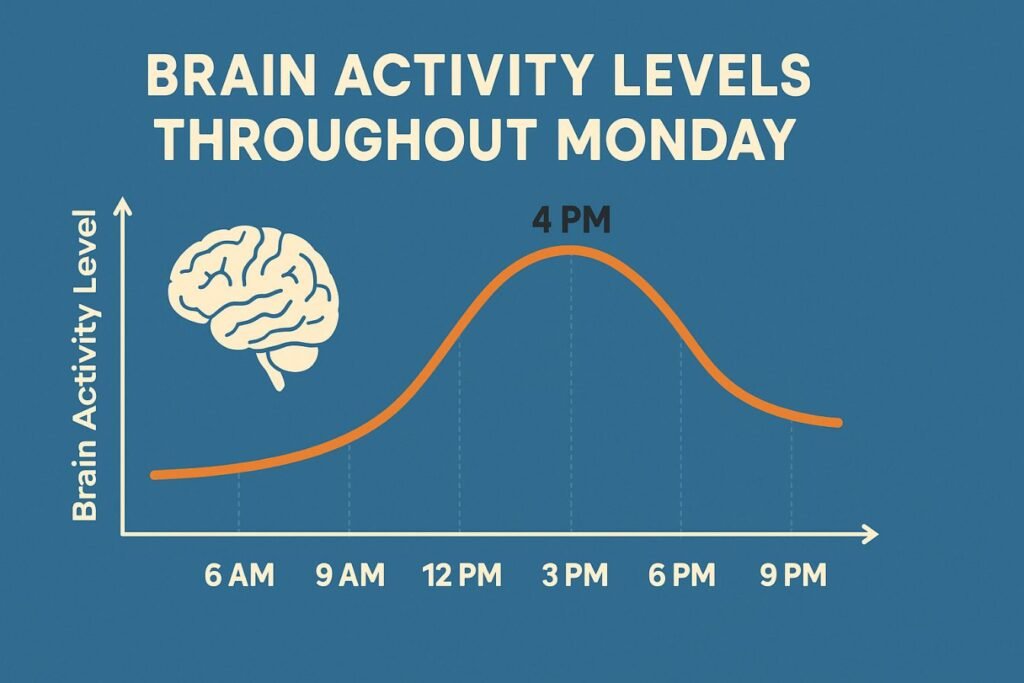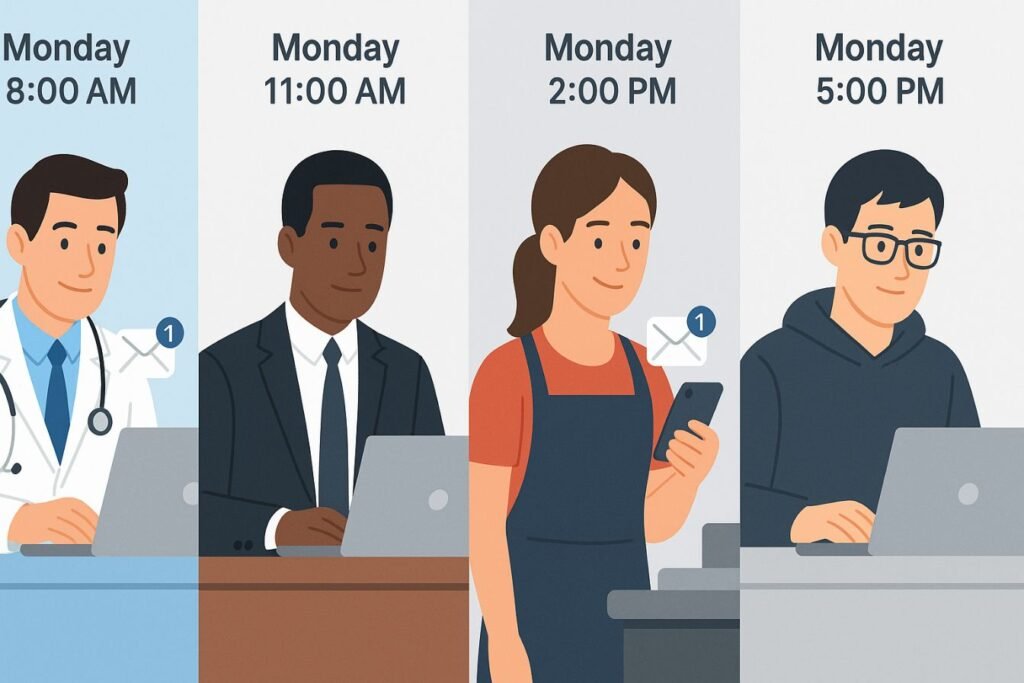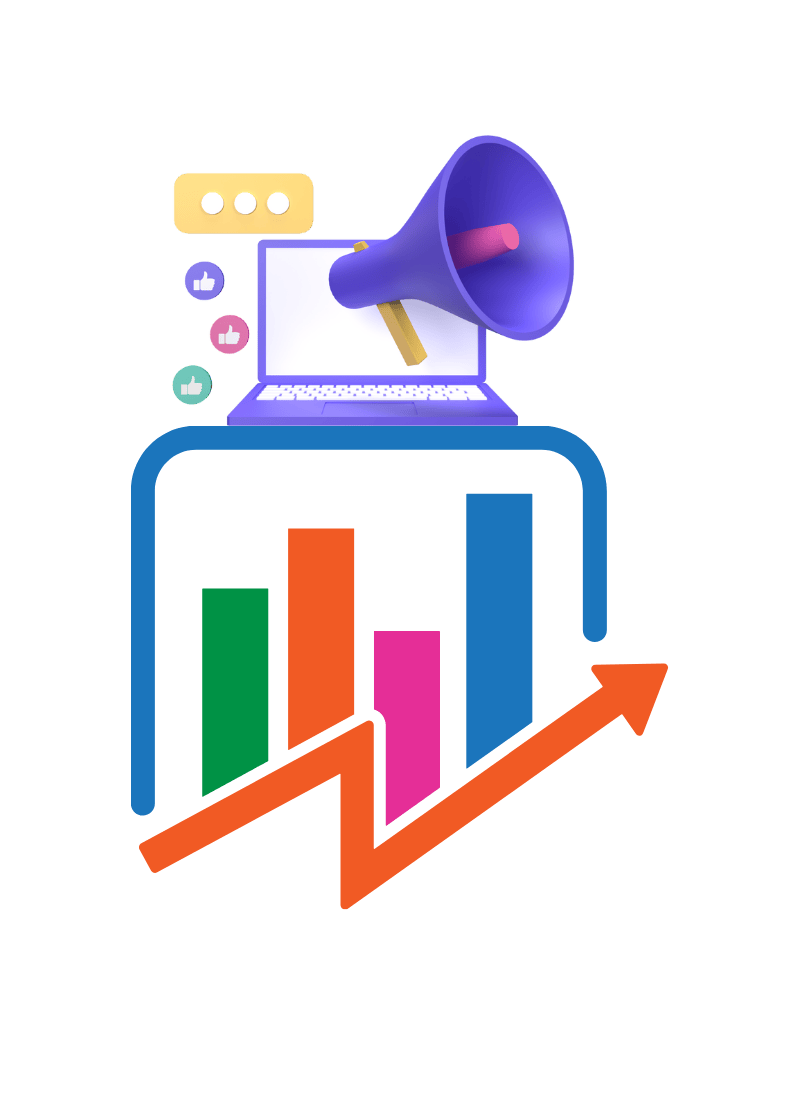The best time to send an email on Monday is 4 PM, according to recent email marketing research. However, this timing strategy goes beyond simply hitting send at the right hour. Monday presents unique challenges and opportunities for email marketers, as it’s the day when professionals return from the weekend, catch up on accumulated messages, and gradually settle into their work rhythm. Understanding the psychology behind Monday email behavior, combined with data-driven timing strategies, can significantly boost your email engagement rates and help your messages stand out in crowded inboxes.
Why Monday Email Timing Matters More Than You Think
Monday stands as one of the most complex days for email marketing success. Unlike other weekdays where people maintain consistent routines, Monday represents a transitional period that directly impacts how recipients interact with their inbox. The psychology of Monday morning creates a perfect storm of factors that email marketers must navigate carefully.
When Monday arrives, professionals face an immediate challenge: processing the weekend email backlog while simultaneously planning their upcoming week. This dual pressure creates a unique window of opportunity and risk for marketers. Send too early, and your message gets buried under weekend accumulation. Send too late, and you miss the prime engagement window when people are most receptive to new information.
Furthermore, Monday email performance serves as a crucial indicator for your entire week’s campaign success. Since many businesses use Monday to launch weekly newsletters, promotional campaigns, and important announcements, the competition for inbox attention intensifies significantly. Understanding the optimal timing becomes not just about reach, but about standing out in an increasingly crowded digital landscape.

The Best Time to Send an Email on Monday: Data-Driven Insights
Research consistently points to 4 PM as the optimal time for Monday email delivery. This timing aligns perfectly with the natural rhythm of professional workdays, when recipients have successfully navigated their morning catch-up period and entered a more receptive mindset for engaging with new content.
The 4 PM sweet spot emerges from understanding Monday’s unique email consumption patterns. MailerLite’s comprehensive analysis reveals that Monday open rates begin increasing around 9 AM but reach their peak performance window between 2 PM and 7 PM. This afternoon surge occurs because professionals have finally cleared their weekend email backlog, attended their Monday morning meetings, and established their weekly priorities.
However, some research suggests a slightly different approach. AudiencePoint recommends the 12 PM to 3 PM window for Monday email delivery, arguing that this timeframe captures recipients during their lunch break when they’re more likely to browse non-urgent emails. This earlier timing strategy can be particularly effective for businesses targeting professionals who maintain strict afternoon schedules.
| Time Window | Open Rate Performance | Ideal For |
|---|---|---|
| 9 AM – 12 PM | Moderate (competing with catch-up) | Time-sensitive updates |
| 12 PM – 3 PM | Good (lunch break browsing) | Newsletter content |
| 4 PM – 6 PM | Highest (settled into routine) | Promotional campaigns |
| 7 PM+ | Declining (end-of-day fatigue) | Personal interest content |
The key insight here is that Monday afternoon timing works because it respects the natural progression of professional energy and attention throughout the day. By 4 PM, recipients have overcome their Monday morning sluggishness and are operating at optimal cognitive capacity for processing marketing messages.
Understanding Monday Email Psychology and Behavior Patterns
Monday email behavior differs significantly from other weekdays due to psychological factors that influence how people process information at the beginning of their work week. The concept of “Monday Blues” isn’t just a cultural phenomenon—it represents a measurable shift in attention, energy levels, and decision-making capacity that directly impacts email engagement rates.
When professionals return from the weekend, they experience what researchers call “transition fatigue.” This mental state makes them less likely to engage with non-essential emails during the morning hours, explaining why early Monday sends often underperform. The brain needs time to shift from weekend relaxation mode to professional focus, creating a natural delay in email responsiveness.
Additionally, Monday mornings trigger a specific type of inbox behavior called “triage mode.” Recipients quickly scan their emails to identify urgent items, often relegating marketing messages to a mental “deal with later” category. This behavior pattern explains why afternoon sends perform better—by then, recipients have completed their triage process and are more open to engaging with promotional content.
The afternoon window also benefits from what behavioral psychologists call “peak cognitive performance.” Most professionals experience their highest energy and decision-making capacity between 2 PM and 6 PM, making this the ideal time for emails that require thoughtful engagement or action.

Monday Email Performance vs. Other Days of the Week
While understanding the best time to send an email on Monday is crucial, it’s equally important to recognize how Monday performs relative to other weekdays. Research consistently shows that mid-week days (Tuesday, Wednesday, and Thursday) generally outperform Monday in terms of overall engagement metrics.
Tuesday emerges as the strongest performer for email marketing, with optimal send times around 7 PM. This later timing works because Tuesday recipients have fully settled into their work week rhythm and are more receptive to marketing messages. Wednesday maintains strong performance with a 4 PM optimal send time, representing the peak of weekly professional engagement.
However, Monday offers unique advantages that shouldn’t be overlooked. Historical data shows that Monday newsletters achieved a 12.9% open rate in comprehensive industry studies, making it the top performer for newsletter content specifically. This suggests that while Monday may not be ideal for all email types, it excels for informational and educational content.
The comparison becomes more nuanced when considering click-through rates versus open rates. While Monday may lag behind mid-week days in opens, it often performs competitively in click-through metrics, particularly for emails sent during the optimal afternoon window. This suggests that Monday recipients who do engage tend to be highly motivated and likely to take action.
| Day | Best Send Time | Average Open Rate | Content Type Advantage |
|---|---|---|---|
| Monday | 4 PM | Moderate-High | Newsletters, Updates |
| Tuesday | 7 PM | Highest | Promotional, Sales |
| Wednesday | 4 PM | High | General Marketing |
| Thursday | 7 PM | High | Decision-driven Content |
| Friday | 6 PM | Moderate | Casual, Entertainment |
Industry-Specific Monday Email Timing Strategies
The best time to send an email on Monday varies significantly across different industries, with each sector exhibiting unique consumption patterns that smart marketers leverage for improved performance. Understanding these industry-specific nuances can dramatically improve your Monday email success rates.
B2B Professional Services benefit most from the traditional 4 PM Monday send time. These audiences are typically office-based professionals who follow conventional work schedules and check emails throughout their workday. The afternoon timing allows them to process your message after completing their morning priorities while still maintaining focus for business-related content.
Retail and E-commerce businesses often find success with slightly earlier Monday timing, around 2 PM to 3 PM. This timing captures professionals during lunch breaks when they’re more likely to browse shopping-related content. Additionally, Monday afternoon shopping emails can capitalize on weekend browsing behavior, as recipients may have spent their weekend researching products online.
Healthcare and Professional Services targeting busy practitioners might find morning sends (9 AM to 11 AM) more effective, despite general data suggesting afternoon superiority. Medical professionals often check emails early in their day before patient care responsibilities intensify, making morning delivery crucial for reaching this audience.
Financial Services and insurance companies typically see strong Monday performance with 4 PM to 5 PM sends. This timing aligns with end-of-business-day planning and decision-making processes that financial professionals often engage in on Mondays as they plan their week.
The key to industry-specific success lies in understanding your audience’s Monday routine and energy patterns. Technology companies targeting developers might find late afternoon sends effective, while companies serving working parents might see better engagement during lunch hour sends.

Advanced Strategies to Optimize Your Monday Email Campaigns
Beyond timing, several advanced strategies can significantly improve your Monday email performance and help your messages stand out in competitive inboxes. These tactics work synergistically with optimal send times to create compound improvements in engagement rates.
Subject Line Optimization for Monday Mindset requires understanding the unique psychological state of Monday recipients. Research indicates that shorter subject lines (4-15 characters) achieve higher open rates on Mondays, with 16.8% performance improvements over longer alternatives. However, Monday subject lines should also address the recipient’s mental state—using phrases like “Quick update,” “Week ahead,” or “Monday motivation” can improve relevance and engagement.
Content Structure for Monday Consumption should acknowledge that Monday readers often skim rather than deeply read emails. Use bullet points, clear headers, and concise paragraphs to make your content easily digestible. Monday emails benefit from front-loading the most important information, as recipients may not scroll through lengthy content during their busy morning catch-up period.
Personalization Strategy for Monday Emails proves particularly effective because Monday recipients are transitioning back into professional mode and appreciate content that feels relevant to their current situation. However, while personalized subject lines may reduce open rates, personalized message content significantly enhances click-through rates.
Segmentation Timing for Monday Audiences can dramatically improve performance by recognizing that not all Monday recipients follow the same schedule. Consider segmenting your list based on time zones, job functions, or engagement history to deliver your Monday emails at the most appropriate time for each recipient group.
The most successful Monday email campaigns also incorporate sequential messaging strategies, where the Monday email serves as the first touchpoint in a weekly email sequence. This approach treats Monday as a relationship-building opportunity rather than just a single promotional attempt.
Common Monday Email Marketing Mistakes to Avoid
Understanding what not to do can be just as valuable as knowing the best practices for Monday email timing. Several common mistakes consistently undermine Monday email performance, even when marketers nail the optimal send time.
Over-Scheduling Monday Mornings represents one of the most frequent errors. Many marketers assume that early Monday sends will capture recipients as they start their week, but this strategy often backfires. Monday morning inboxes are typically flooded with weekend accumulation, urgent work communications, and catch-up emails, making it nearly impossible for marketing messages to gain attention.
Ignoring Monday’s Unique Mental State leads to content mismatches that reduce engagement. Monday recipients are often in planning and organizing mode rather than purchasing or decision-making mode. Emails that require immediate action or complex decision-making often perform poorly on Mondays, regardless of send time.
Applying Generic Best Practices without considering Monday-specific factors creates missed opportunities. For example, the general rule about morning email sends doesn’t apply to Mondays, where afternoon timing consistently outperforms earlier delivery.
Neglecting Mobile Optimization becomes particularly problematic on Mondays when many professionals catch up on emails during commutes or while moving between meetings. Monday emails must be fully optimized for mobile viewing to capture this mobile-heavy audience segment.
Competing with Internal Communications by sending emails during peak internal company communication times (typically Monday morning) reduces visibility and engagement. Smart marketers avoid the 8 AM to 11 AM window when internal team emails and meeting requests dominate professional inboxes.
The most successful Monday email strategies acknowledge these pitfalls and specifically design campaigns to avoid common timing and content mistakes that reduce engagement rates.
Testing and Measuring Your Monday Email Performance
Developing an effective Monday email strategy requires systematic testing and measurement to identify what works best for your specific audience. The best time to send an email on Monday isn’t just about following general guidelines—it’s about discovering your audience’s unique preferences through careful experimentation.
A/B Testing Monday Send Times should focus on narrow time windows rather than broad comparisons. Test 3 PM versus 4 PM versus 5 PM sends to identify your optimal window, rather than comparing morning versus afternoon sends. This granular approach provides more actionable insights for fine-tuning your Monday timing strategy.
Segmented Time Testing can reveal important audience differences that impact Monday performance. Professional audiences might respond better to late afternoon sends, while consumer audiences might prefer earlier timing. Testing different segments at different times can optimize overall campaign performance.
Performance Metrics Beyond Open Rates provide crucial insights for Monday email optimization. While open rates indicate initial engagement, click-through rates, conversion rates, and unsubscribe rates offer deeper understanding of Monday email effectiveness. Monday emails often show different patterns across these metrics compared to other weekdays.
Seasonal Testing Considerations become particularly important for Monday emails because Monday psychology can shift based on factors like holiday schedules, quarterly business cycles, and seasonal work patterns. Your optimal Monday send time might vary between January (New Year planning mode) and August (summer schedule disruptions).
Long-term Performance Tracking helps identify trends and patterns that emerge over months rather than weeks. Monday email performance often improves as audiences become accustomed to receiving and engaging with your Monday content, making consistency as important as timing.
| Metric | Monday Benchmark | Testing Frequency | Key Insights |
|---|---|---|---|
| Open Rate | Industry Average + 10% | Weekly | Timing effectiveness |
| Click Rate | 2-15% (B2B), 2-12% (B2C) | Bi-weekly | Content relevance |
| Conversion Rate | Track against Tuesday-Thursday | Monthly | Overall campaign success |
| Unsubscribe Rate | <0.5% | Monthly | Audience satisfaction |
Future Trends in Monday Email Marketing
The landscape of Monday email marketing continues evolving as workplace patterns shift and new technologies emerge. Understanding these trends helps marketers prepare for changes that could impact the best time to send an email on Monday in coming years.
Remote Work Impact on Monday Timing has already begun shifting traditional patterns as more professionals work from home. Remote workers often start their day later and maintain more flexible schedules, potentially extending the optimal Monday send window or shifting it earlier to accommodate different work patterns.
AI-Powered Send Time Optimization tools are becoming more sophisticated at predicting individual recipient behavior, potentially making general “best time” recommendations less relevant. These tools can identify when specific subscribers are most likely to engage, regardless of general Monday trends.
Mobile-First Email Consumption continues growing, with Monday emails increasingly viewed on smartphones during commutes or while multitasking. This trend favors shorter, more visual content and may impact optimal timing as mobile usage patterns differ from desktop email checking.
Integration with Calendar and Productivity Apps could revolutionize Monday email timing by allowing marketers to avoid sending emails when recipients are in meetings or focused work sessions. This technology could make Monday afternoon sends even more effective by ensuring emails arrive during genuine break periods.
As these trends develop, successful Monday email marketing will require flexibility and continuous adaptation rather than rigid adherence to current timing recommendations.

Conclusion: Mastering Monday Email Success
The best time to send an email on Monday is 4 PM, but successful Monday email marketing extends far beyond simple timing. Understanding the psychology behind Monday recipient behavior, avoiding common pitfalls, and continuously testing your approach creates a foundation for sustained Monday email success.
Monday presents unique challenges and opportunities that require specialized strategies rather than generic email marketing approaches. By respecting your audience’s Monday mindset, optimizing for mobile consumption, and focusing on relationship-building rather than immediate sales, you can transform Monday into a powerful day for email engagement.
Remember that the most successful Monday email campaigns combine optimal timing with relevant content, clear messaging, and respect for recipient attention spans. As workplace patterns continue evolving, staying flexible and responsive to your audience’s changing needs will ensure your Monday emails continue driving results.
Ready to optimize your Monday email campaigns? Start by testing different send times within the 2 PM to 6 PM window to identify your audience’s sweet spot. Then, implement the content and timing strategies outlined above to maximize your Monday email performance. Share your Monday email success stories in the comments below, and don’t forget to subscribe to MarketingOWO for more data-driven email marketing insights delivered straight to your inbox every week.
What Monday email timing strategies have worked best for your business? Have you noticed different patterns in your industry? Join the conversation and help fellow marketers optimize their Monday email performance!




